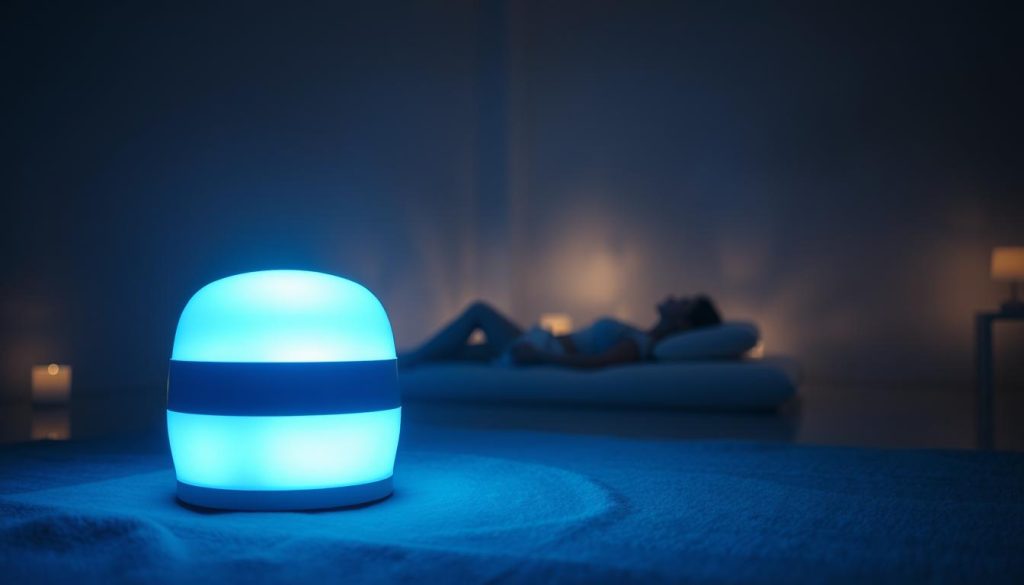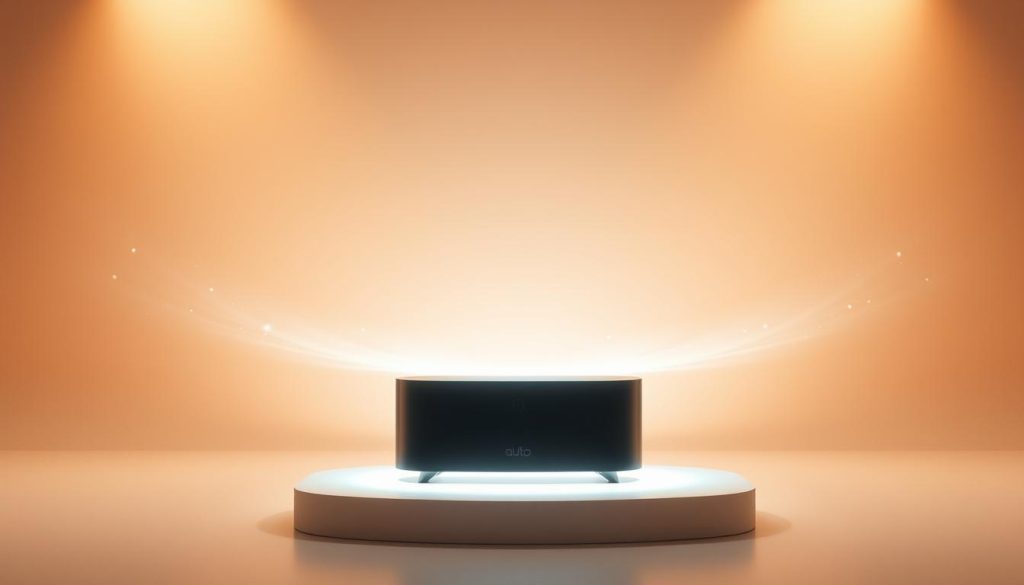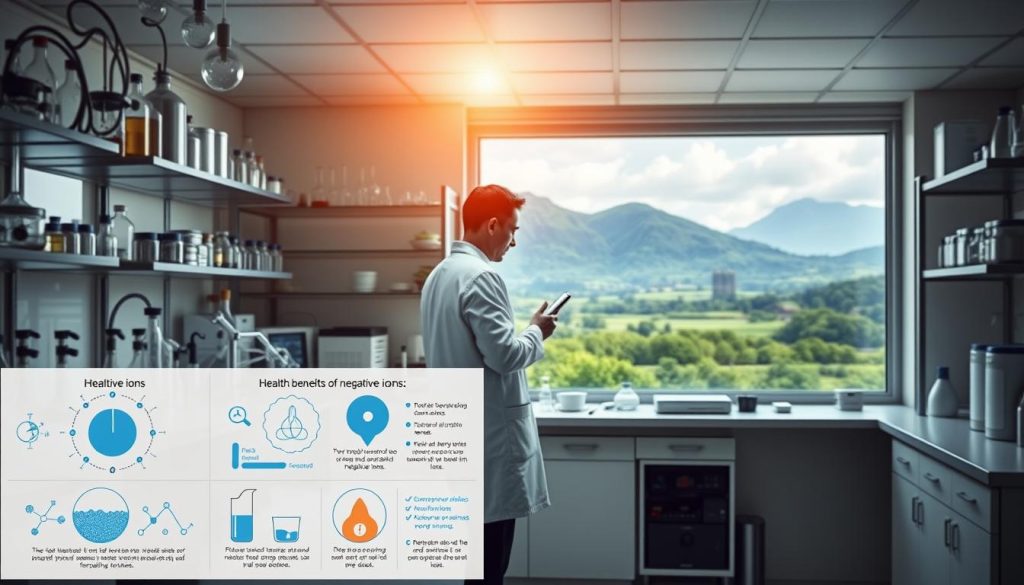Have you ever felt refreshed and clear after walking in the woods or near a waterfall? The secret might be negative ions. These ions, found in nature, can boost our health and wellbeing. Studies show they improve air quality and offer health benefits.
As cities grow, knowing about ionized air benefits is key for our health.
We’ll look into the science of negative ions and their health benefits. We’ll see how they can lift our mood, boost energy, and clear our minds. We’ll also explore technologies and therapies that use negative ions.
And, we’ll find ways to add these natural enhancers to our daily lives for better health.
What Are Negative Ions?
Negative ions, also known as anions, are atoms or molecules with extra electrons. This makes them negatively charged. They are different from positively charged ions, or cations, which don’t have extra electrons.
Negative ions are common in nature, like in forests, mountains, and waterfalls. These places have lots of moving water and natural materials. This helps create and release these beneficial ions. But, cities have fewer negative ions because of pollution and less natural stuff.
Negative ions are tiny and can stick to things like dust, mold, and pollen. This helps clean the air. Tools like ion counters and air ion meters help measure these ions. They are key in negative ion science and help with research and therapy.
The Science Behind Negative Ions
Ionization is key in making and working of negative ions. Knowing how ionization works helps us understand the health perks of negative ions.
The Nature of Ionization
Ionization happens when atoms or molecules get or lose electrons. This leads to a positive or negative charge. Negative ions are made when an atom or molecule picks up extra negatively charged electrons. This is how negative ions help improve our health and wellbeing.
How Negative Ions Are Formed
Negative ions are made in many ways. Waterfalls, lightning, and sunlight’s ultraviolet rays are all sources. Waterfalls split water molecules, releasing electrons that turn into negative ions.
Lightning’s huge energy breaks air molecules, creating free electrons. These electrons then stick to other molecules, making more negative ions.
Ultraviolet rays from the sun also help make negative ions. They knock electrons off particles in the air, making lots of negative ions. These natural ways show how nature keeps us supplied with negative ions. They help us feel better, more energetic, and clearer-minded.
Health Benefits of Negative Ions
Negative ions offer many health benefits. They can improve your mood, help with breathing, and even make you think clearer. Adding negative ion therapy to your daily life can make you feel better overall.
Boosting Mood and Energy
Negative ion therapy can make you feel happier and more energetic. Studies show that negative ions help produce serotonin in the brain. This is a key chemical for feeling good and happy.
Many people feel more lively and positive when around negative ions. Places like waterfalls or forests are great for this.
Improving Respiratory Function
Negative ions are also good for your breathing. They stick to pollutants in the air, like dust and allergens. This makes the air cleaner and easier to breathe.
People with asthma or allergies might find it helpful. It can make breathing easier and improve lung function.
Enhancing Mental Clarity
Negative ions can also improve your mind. They help you focus better and think more clearly. Studies have shown this to be true.
Being in places with lots of negative ions can make you more productive. It’s great for work or studying.
Negative Ion Therapy: An Overview
Negative ion therapy is becoming more popular as a way to improve health and mood. It uses negative ion generators to clean the air and possibly offer health benefits. These negative ions are believed to fight free radicals, increase oxygen, and balance serotonin levels.

What Is Negative Ion Therapy?
Negative ion therapy uses negative ions to make the environment healthier and improve well-being. It aims to mimic the natural environments rich in negative ions, like waterfalls and forests. The goal is to reduce stress, anxiety, and depression, and boost overall wellness.
People who try this therapy often feel more relaxed, have better breathing, and a more stable mood.
Methods of Ion Therapy
There are many ways to use ion therapy, each for different needs and places:
- Air Purifiers: Devices with negative ion generators to clean indoor air and remove allergens.
- Wearable Devices: Portable gadgets that release negative ions, worn close to the body for best results.
- Clinical Treatments: Professional settings using advanced negative ion technology for specific treatments.
Studies show that negative ion generators are safe for home and personal use. But, clinical uses should be watched by doctors to ensure safety and effectiveness.
Negative Ions and Improved Wellbeing
Research shows a strong link between negative ions and better wellbeing. Negative ion science explains how these ions can make our lives better. They help reduce stress and improve sleep.
Stress Reduction
Negative ions can help lower stress levels. Ionization therapy uses these ions to counteract stress-causing positive ions. This balance makes us feel calmer and more relaxed.
Improved Sleep Quality
Negative ions also improve sleep. They help produce serotonin, a mood and sleep regulator. People in negative ion-rich areas sleep better and more deeply.
Ionization therapy is a promising way to boost wellbeing. It offers stress relief and better sleep. These natural benefits can greatly improve our health and relaxation.
Technologies Utilizing Negative Ions
Negative ion technology has made big strides in recent years. It’s now found in many products we use every day. Air purifiers, for example, use negative ions to clean the air we breathe. They help remove pollutants and allergens, making our indoor air cleaner.
Wearable devices like bracelets and necklaces are also popular. They claim to improve our mood and reduce stress by exposing us to negative ions all the time.

Negative ion research has led to new sleep aids. Modern mattresses and pillows now have negative ion technology. This technology helps us sleep better by improving the air we breathe and lowering stress hormones.
Even home and office appliances have been updated with negative ions. Fans and humidifiers now help create healthier, fresher environments. These changes show how negative ions can make our lives healthier and more comfortable.
But negative ion technology isn’t just for us. It’s also used in water purification systems and agriculture. In farming, negative ions help plants grow stronger and produce more. This shows how wide-ranging the benefits of negative ion research are.
The table below lists some key technologies that use negative ions and their benefits:
| Technology | Application | Negative Ion Benefits |
|---|---|---|
| Air Purifiers | Indoor air quality improvement | Removes pollutants and allergens |
| Wearable Devices | Mood and stress reduction | Continuous exposure increases mood |
| Sleep Aids | Enhanced sleep quality | Reduces stress hormones |
| Home Appliances | Healthier living environment | Improves air quality |
| Agricultural Applications | Boosts plant growth | Increases yield |
Negative Ion Generators: How They Work
Negative ion generators are key devices that add negative ions to the air. They are vital for negative ion therapy, which offers many ion therapy benefits. To grasp how they work, we need to look at their design and how they operate.
These generators create negative ions by using electricity. They use high voltage to ionize air particles, giving them extra electrons. This makes negative ions available in the air around us.
A negative ion generator has a power supply, discharge wires, and a fan. The power supply energizes the wires, creating a high voltage. Air passing through gets electrons, turning into negative ions. The fan spreads these ions around, making the air cleaner.
Different models of these generators vary in what they can do. Some are small and good for personal use, improving air in small areas. Larger units are made for bigger spaces, showing the ion therapy benefits in making air healthier.
Knowing how negative ion generators work is key to better living spaces. It helps us choose the right negative ion therapy for our homes or offices.
Negative Ion Research and Findings
The study of *health benefits of negative ions* is growing. Recent studies have shown many benefits of *ionized air benefits*. This research shows both proven benefits and areas needing more study.
Recent Studies
Recent studies show negative ions can greatly improve health and happiness. A 2021 study at the University of California found that negative ions boost brain function and mood. They also found that these ions help lower stress and anxiety.

Potential Health Improvements
The American Journal of Epidemiology has also looked into *health benefits of negative ions*. They found that these ions can help with breathing problems like asthma. But, they say more research is needed to fully understand these benefits.
Even though studies are promising, more research is needed. This will help us fully understand the *health benefits of negative ions* and *ionized air benefits*.
Integrating Negative Ions into Daily Life
Adding more negative ions to your daily life can boost your well-being. Using negative ion generators is a simple way to do this. These devices release negative ions into the air, making it cleaner and healthier.
Place these generators in rooms you use a lot, like living areas and offices. This can improve the air quality and your mood.
Spending time in nature is another easy way to get more negative ions. Activities like hiking, walking by the ocean, or visiting waterfalls are great. These places have lots of negative ions, helping you feel better without any extra gadgets.
Changing your lifestyle can also help you get more negative ions. Adding plants to your home or using air purifiers with negative ion tech can keep your air clean. Exercising outside, where the air is fresh, can also increase your negative ion intake. This can make you feel better physically and mentally.
Exploring Natural Sources of Negative Ions
Nature is full of negative ions that boost our well-being. Places like waterfalls, beaches, and forests have lots of these ions. Waterfalls and beaches create negative ions, making the air feel fresh and lively.
Forests, full of greenery, are also great for negative ions. They show how nature and science work together. This is called ionization therapy.
Doing activities like forest bathing and hiking in mountains helps us connect with nature. It also lets us get more negative ions. These activities help reduce stress and improve our mood and energy.
Research supports these benefits, showing how important natural ion therapy is for health. It helps us feel better and live healthier lives.
Where you live or travel to affects the amount of negative ions you get. Coastal areas, mountains, and forests have different levels of these ions. Knowing this helps us choose the best places for our health.
Whether you’re going to the beach or the mountains, knowing about negative ions helps. It lets us make choices that improve our well-being. As we learn more about negative ions, they become a big part of our health routine.

